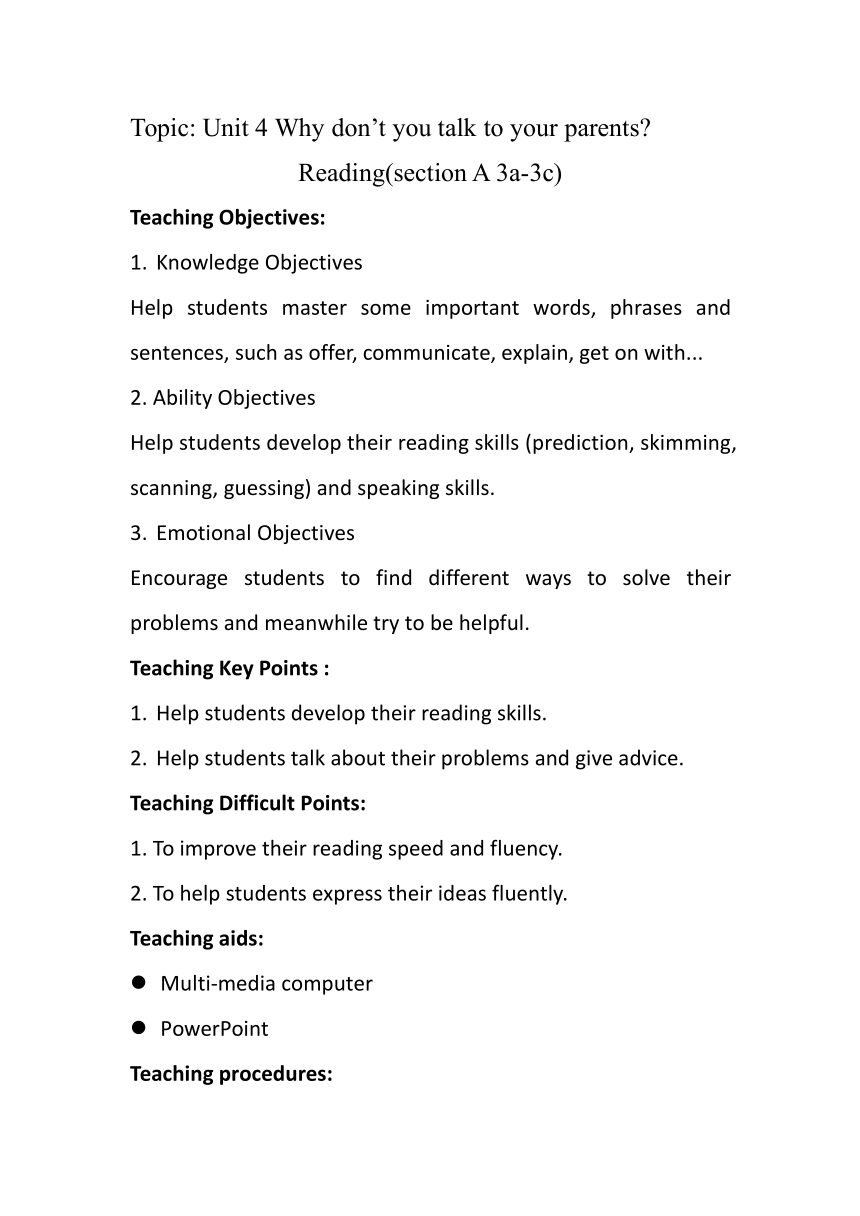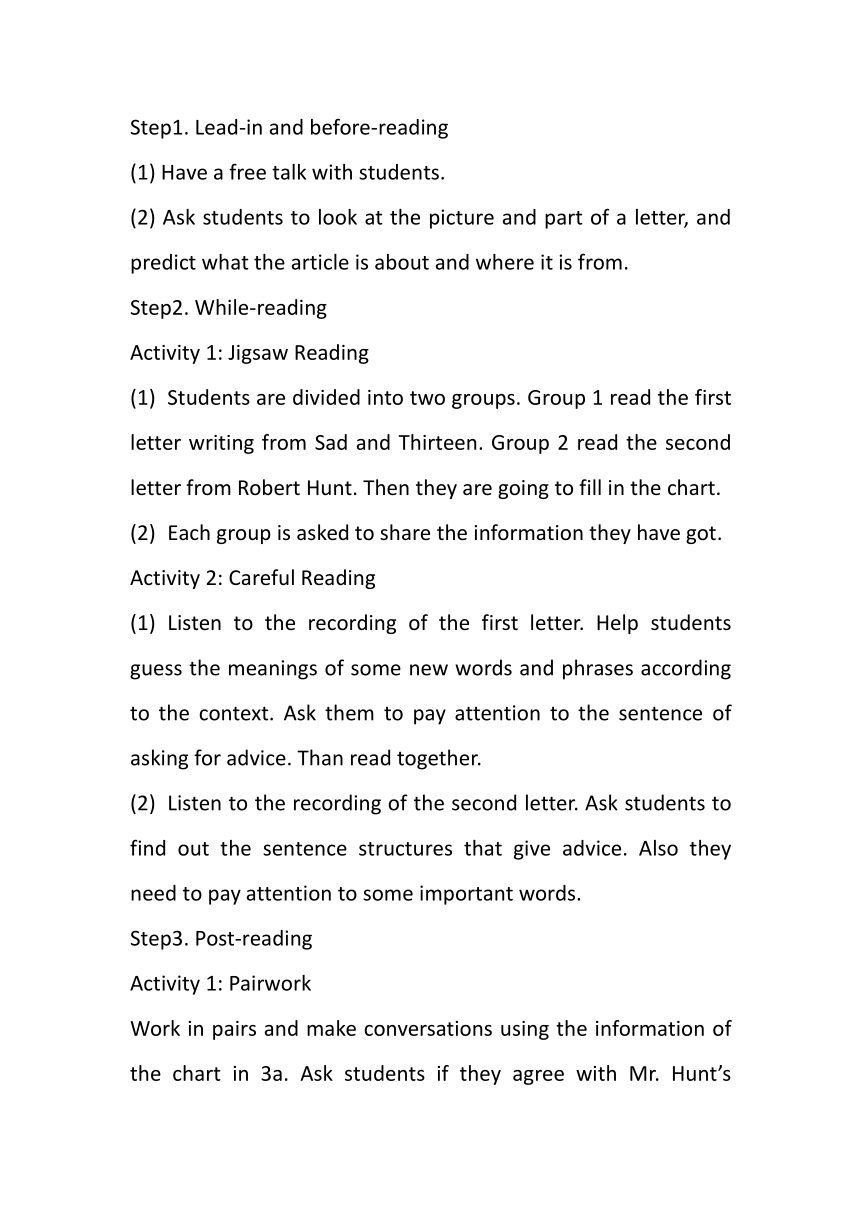人教版八年级下册 Unit 4 Why don't you talk to your parents? Section A 3a-3c 教案
文档属性
| 名称 | 人教版八年级下册 Unit 4 Why don't you talk to your parents? Section A 3a-3c 教案 |  | |
| 格式 | doc | ||
| 文件大小 | 35.0KB | ||
| 资源类型 | 教案 | ||
| 版本资源 | 人教新目标(Go for it)版 | ||
| 科目 | 英语 | ||
| 更新时间 | 2022-12-28 10:20:02 | ||
图片预览


文档简介
Topic: Unit 4 Why don’t you talk to your parents
Reading(section A 3a-3c)
Teaching Objectives:
1. Knowledge Objectives
Help students master some important words, phrases and sentences, such as offer, communicate, explain, get on with...
2. Ability Objectives
Help students develop their reading skills (prediction, skimming, scanning, guessing) and speaking skills.
3. Emotional Objectives
Encourage students to find different ways to solve their problems and meanwhile try to be helpful.
Teaching Key Points :
1. Help students develop their reading skills.
2. Help students talk about their problems and give advice.
Teaching Difficult Points:
1. To improve their reading speed and fluency.
2. To help students express their ideas fluently.
Teaching aids:
Multi-media computer
PowerPoint
Teaching procedures:
Step1. Lead-in and before-reading
(1) Have a free talk with students.
(2) Ask students to look at the picture and part of a letter, and predict what the article is about and where it is from.
Step2. While-reading
Activity 1: Jigsaw Reading
(1) Students are divided into two groups. Group 1 read the first letter writing from Sad and Thirteen. Group 2 read the second letter from Robert Hunt. Then they are going to fill in the chart.
(2) Each group is asked to share the information they have got.
Activity 2: Careful Reading
(1) Listen to the recording of the first letter. Help students guess the meanings of some new words and phrases according to the context. Ask them to pay attention to the sentence of asking for advice. Than read together.
(2) Listen to the recording of the second letter. Ask students to find out the sentence structures that give advice. Also they need to pay attention to some important words.
Step3. Post-reading
Activity 1: Pairwork
Work in pairs and make conversations using the information of the chart in 3a. Ask students if they agree with Mr. Hunt’s advice. If they don’t agree, they can use their own ideas.
Activity 2: Groupwork
Four students in a group and do a survey. Fill in the questionnaire. Then present some of them.
Step4. Summary and Emotional Education
1. Summarize what we learned today.
2. Encourage students to find different ways to solve their problems and meanwhile try to be helpful.
Blackboard Design:
Reflection and evaluation: (Omitted)
______________________________________________________________________________________________________________________________________________________________________________________________________________________________________
______________________________________________
Giving advice
Why don’t you...
You should/could...
Why not...
What/How about..
asking for advice
What can I do
Can you help me
Could you give me some advice
problems
Try to find ways to solve your problems!
Don’t forget to be helpful!
PAGE
Reading(section A 3a-3c)
Teaching Objectives:
1. Knowledge Objectives
Help students master some important words, phrases and sentences, such as offer, communicate, explain, get on with...
2. Ability Objectives
Help students develop their reading skills (prediction, skimming, scanning, guessing) and speaking skills.
3. Emotional Objectives
Encourage students to find different ways to solve their problems and meanwhile try to be helpful.
Teaching Key Points :
1. Help students develop their reading skills.
2. Help students talk about their problems and give advice.
Teaching Difficult Points:
1. To improve their reading speed and fluency.
2. To help students express their ideas fluently.
Teaching aids:
Multi-media computer
PowerPoint
Teaching procedures:
Step1. Lead-in and before-reading
(1) Have a free talk with students.
(2) Ask students to look at the picture and part of a letter, and predict what the article is about and where it is from.
Step2. While-reading
Activity 1: Jigsaw Reading
(1) Students are divided into two groups. Group 1 read the first letter writing from Sad and Thirteen. Group 2 read the second letter from Robert Hunt. Then they are going to fill in the chart.
(2) Each group is asked to share the information they have got.
Activity 2: Careful Reading
(1) Listen to the recording of the first letter. Help students guess the meanings of some new words and phrases according to the context. Ask them to pay attention to the sentence of asking for advice. Than read together.
(2) Listen to the recording of the second letter. Ask students to find out the sentence structures that give advice. Also they need to pay attention to some important words.
Step3. Post-reading
Activity 1: Pairwork
Work in pairs and make conversations using the information of the chart in 3a. Ask students if they agree with Mr. Hunt’s advice. If they don’t agree, they can use their own ideas.
Activity 2: Groupwork
Four students in a group and do a survey. Fill in the questionnaire. Then present some of them.
Step4. Summary and Emotional Education
1. Summarize what we learned today.
2. Encourage students to find different ways to solve their problems and meanwhile try to be helpful.
Blackboard Design:
Reflection and evaluation: (Omitted)
______________________________________________________________________________________________________________________________________________________________________________________________________________________________________
______________________________________________
Giving advice
Why don’t you...
You should/could...
Why not...
What/How about..
asking for advice
What can I do
Can you help me
Could you give me some advice
problems
Try to find ways to solve your problems!
Don’t forget to be helpful!
PAGE
同课章节目录
- Unit 1 What's the matter?
- Section A
- Section B
- Unit 2 I'll help to clean up the city parks.
- Section A
- Section B
- Unit 3 Could you please clean your room?
- Section A
- Section B
- Unit 4 Why don't you talk to your parents?
- Section A
- Section B
- Unit 5 What were you doing when the rainstorm came
- Section A
- Section B
- Review of Units 1-5
- Unit 6 An old man tried to move the mountains.
- Section A
- Section B
- Unit 7 What's the highest mountain in the world?
- Section A
- Section B
- Unit 8 Have you read Treasure Island yet?
- Section A
- Section B
- Unit 9 Have you ever been to a museum?
- Section A
- Section B
- Unit 10 I've had this bike for three years.
- Section A
- Section B
